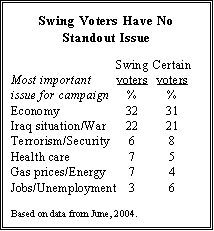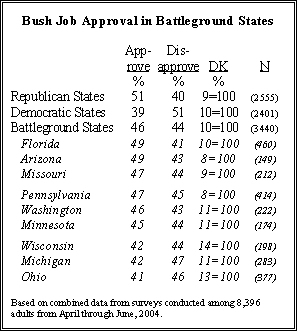Summary of Findings
 There are considerably fewer swing voters now than at this point in the previous three presidential campaigns. But the swing vote, while smaller in relative terms, is still substantial and certainly large enough for a presidential candidate to win a big victory. Pew’s most recent survey, conducted June 3-13, finds 21% of registered voters either undecided or, having expressed a preference, saying there is a chance they might change their mind.
There are considerably fewer swing voters now than at this point in the previous three presidential campaigns. But the swing vote, while smaller in relative terms, is still substantial and certainly large enough for a presidential candidate to win a big victory. Pew’s most recent survey, conducted June 3-13, finds 21% of registered voters either undecided or, having expressed a preference, saying there is a chance they might change their mind.
That is about the same percentage that was still weighing its options at the end of the last presidential campaign. At this point four years ago, fully 32% of voters were not yet committed. In July 1996, the last election in which an incumbent president stood for reelection, 27% were open to persuasion; in May 1992, the comparable number was 31%.
 Within the swing group, 8% lean to Bush, 7% to Kerry, and 6% refused to lean to either candidate. The number of voters not yet solidly aligned behind Bush or Kerry has declined since February, when 29% were still not certain. In the current survey, committed voters are evenly divided between George Bush and John Kerry (40% Bush, 39% Kerry).
Within the swing group, 8% lean to Bush, 7% to Kerry, and 6% refused to lean to either candidate. The number of voters not yet solidly aligned behind Bush or Kerry has declined since February, when 29% were still not certain. In the current survey, committed voters are evenly divided between George Bush and John Kerry (40% Bush, 39% Kerry).
An analysis by the Pew Research Center for the People and the Press finds that swing voters come from almost all demographic categories. But they are distinguished from committed voters by their political moderation and by the fact that they have favorable opinions of both Bush and Kerry. A solid majority of swing voters (56%) have a favorable view of Bush, while a comparable number (53%) has a positive opinion of Kerry. Roughly a third (34%) hold a positive view of both candidates, compared with only 7% of committed voters.
It is too early in the campaign to be able to identify likely voters with great precision. But the swing group makes up a somewhat smaller percentage of likely voters (17%) than it does of the overall electorate (21%). At this stage in the 2000 campaign, swing voters constituted roughly a quarter of likely voters (26%).

The presidential candidates are increasingly targeting uncommitted voters living in so-called battleground states those that have been closely contested in recent elections or where neither candidate appears to have a safe lead this year.1 In these states, 22% of voters are uncommitted, about the same level as nationally. This small group of potentially pivotal voters currently constitutes just 9% of the overall electorate.
Who Are the Swing Voters?
 The profile of the uncommitted yields few clues about how they might break on Election Day. They are somewhat less engaged in the campaign: Only about one-in-five swing voters (21%) say they have closely followed news about the campaign. That compares with 38% of Kerry voters and 32% of Bush voters. In addition, fewer swing voters say they have given a lot of thought to the campaign just 40% have thought a lot about the election, compared with 60% of Bush voters and 67% of Kerry voters.
The profile of the uncommitted yields few clues about how they might break on Election Day. They are somewhat less engaged in the campaign: Only about one-in-five swing voters (21%) say they have closely followed news about the campaign. That compares with 38% of Kerry voters and 32% of Bush voters. In addition, fewer swing voters say they have given a lot of thought to the campaign just 40% have thought a lot about the election, compared with 60% of Bush voters and 67% of Kerry voters.
Roughly half of swing voters (47%) approve of Bush’s overall job performance, which is comparable to Bush’s rating among certain voters (48%). Majorities in both groups give Bush positive marks on handling terrorism (57% each). But swing voters are somewhat less likely than other registered voters to approve of Bush’s management of the economy and his handling of the war in Iraq.
Uncommitted voters tend to be more moderate in their political outlook than those who have settled on a candidate. In June, 49% described themselves as moderates, compared with 33% of committed voters. Similarly, 45% decline to identify with a party (including 38% who say they are independent), compared with just 26% among the committed. In the current survey, the swing vote group includes more Democrats than Republicans (36% vs. 18%), but that balance has fluctuated greatly over the past few months, as might be expected with voters who do not have strong political preferences.

Swing voters are not especially different from the overall electorate demographically. More are Catholic and fewer are white evangelicals, but otherwise they are not distinctive.
Moreover, swing voters express almost precisely the same issue priorities as voters who say they have already made up their minds. Among swing voters, 32% pick the economy as the most important issue for the candidates to discuss; 31% of those certain of their choice say the same. Similarly, 22% of swing voters want to hear about Iraq, but so too do 21% of the committed voters.
Partisans Locked In
 Not surprisingly, ideologically-motivated partisans are solidly behind their respective candidates even more so than they were four years ago. Just 6% of conservative Republicans today are considered swing voters, compared with 14% at this same time in the 2000 campaign. By comparison, a higher proportion of liberal Democrats are open to persuasion (17%), but that is down six points since June 2000.
Not surprisingly, ideologically-motivated partisans are solidly behind their respective candidates even more so than they were four years ago. Just 6% of conservative Republicans today are considered swing voters, compared with 14% at this same time in the 2000 campaign. By comparison, a higher proportion of liberal Democrats are open to persuasion (17%), but that is down six points since June 2000.
Independents are divided on the choice between Bush and Kerry, and significant numbers of independents are still uncommitted. Yet they also are far more decided, as a group, than in 2000. Four years ago, nearly half of independents (45%) were undecided or said they might change their minds; today, fewer than three-in-ten (28%) say this a drop of 17 percentage points. Indeed, there are nearly as many swing voters among moderate and liberal Republicans as among independents.
Battleground States
 The battleground states in this year’s election, while obviously very competitive, do not have a disproportionately high percentage of swing voters. Just 22% of voters in battleground states are undecided or still considering the other candidate. This is comparable to the number of swing voters in the firm Democratic (22%) and Republican states (18%).
The battleground states in this year’s election, while obviously very competitive, do not have a disproportionately high percentage of swing voters. Just 22% of voters in battleground states are undecided or still considering the other candidate. This is comparable to the number of swing voters in the firm Democratic (22%) and Republican states (18%).
The closely contested presidential race in battleground states (42% say they are certain to support Bush, 36% Kerry) is reflected in other evaluations as well.
 Battleground states are equally split with respect to the president’s performance 46% in those states approve while 44% disapprove. And this division is similar across most individual states within the battleground as well.
Battleground states are equally split with respect to the president’s performance 46% in those states approve while 44% disapprove. And this division is similar across most individual states within the battleground as well.
Of the major battleground states, people in Florida and Arizona are the most favorable in their evaluations of the president (49% approve), while those in Michigan and Ohio are the most critical (42% and 41% approve, respectively), but no major battleground state is as supportive of the president as are residents of the red states, and none are as critical as residents of the blue states.
Similarly, residents of the major battleground states fall squarely between their counterparts in red and blue America with respect to the war in Iraq. A slim majority (54%) says the war was the right decision, four percent fewer than in the red states, and five percent more than in the blue states. And again, there is little variation across states within the battleground.
Contested Constituencies
 Bush and Kerry are running neck-and-neck in the overall horse race, and many groups are as closely contested as they were in 2000. Notably, independents divide almost evenly (47% Kerry, 45% Bush), as do high school graduates, middle-income voters, and women age 30-64.
Bush and Kerry are running neck-and-neck in the overall horse race, and many groups are as closely contested as they were in 2000. Notably, independents divide almost evenly (47% Kerry, 45% Bush), as do high school graduates, middle-income voters, and women age 30-64.
White Catholics also continue to be a contested constituency they divided almost evenly between Bush and Gore in 2000, and are split between Kerry (48%) and Bush (47%) today. But Kerry has closed the gap among the most observant Catholics. Four years ago, Bush won by a wide margin among white Catholics who attend church at least weekly (59%-39%). Today, these more observant Catholics are divided evenly (47% each), as are their less-committed counterparts.
Hispanic voters lean toward Kerry (53% vs. 41%), but Bush is doing better in this key group than in 2000 when Gore won


